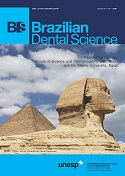Mechanical properties of bulk-fill versus nanohybrid composites: effect of layer thickness and application protocols
DOI:
https://doi.org/10.14295/bds.2019.v22i2.1719Abstract
Objective: The objective of this study was to evaluate the compressive strength, flexural strength and flexural modulus of high-viscosity, low-viscosity bulk-fill, and conventional nano-hybrid resin composite materials alone and when covered with nano-hybrid resin composite at different incremental thicknesses on the bulk-fill composites. Materials and Methods: Specimens (N=60) were fabricated from the following materials or their combinations (n=10 per group): a) conventional nano-hybrid composite Z550 (FK), b) high-viscosity bulk-fill composite (Tetric N Ceram-TBF), c) low-viscosity bulk-fill composite SDR (SDR), d) Sonicfill (SF), e) SDR (2 mm)+FK (2 mm), f) SDR (4 mm)+FK (4 mm). After 24 h water storage, compressive strength was measured in a universal testing machine (1 mm/min). Additional specimens (N=40) (25x2x2 mm3) were made from FK, TBF, SDR and SF in order to determine the flexural strength and the flexural modulus, (n=10) and subjected to three-point bending test (0.5 mm/min). Data were analyzed using one-way ANOVA and Tamhane’s T2 post-hoc tests (p<0.05). Results: The mean compressive strength (MPa) of the nano-hybrid composite (FK) was significantly higher (223.8±41.3) than those of the other groups (123±27 - 170±24) (p<0.001). SDR (4 mm)+FK (2 mm) showed significantly higher compressive strength than when covered with 4 mm (143±30) or when used alone (146±11) (p<0.05). The mean flexural strength (159±31) and the flexural modulus of FK (34±7) was significantly higher than that of the high- or low-viscosity bulk-fill composites (p<0.001). The mean flexural strength of SF (132±20) was significantly higher compared to TBF (95±25) (p<0.05). Conclusion: Bulk-fill resin composites demonstrated poorer mechanical properties compared to nano-hybrid composite but similar to that of SF. Increasing the thickness of low-viscosity bulk-fill composite (SDR) from 2 to 4 mm underneath the nano-hybrid composite (FK) can improve the mechanical properties of the bulk-fill composites.
Keywords
Bulk-fill composites; Compressive strength; Flexural modulus; Flexural strength; Mechanical properties.
Downloads
Downloads
Published
How to Cite
Issue
Section
License
Brazilian Dental Science uses the Creative Commons (CC-BY 4.0) license, thus preserving the integrity of articles in an open access environment. The journal allows the author to retain publishing rights without restrictions.
=================




























